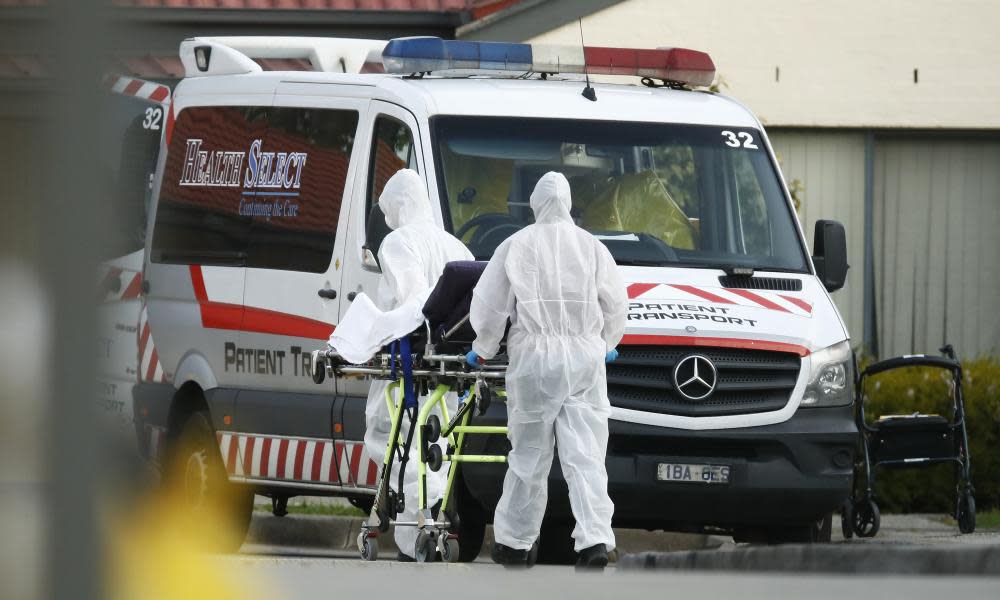Minister refuses to name Victoria aged care homes battling Covid-19 due to 'reputational' fears

The federal aged care minister and officials from the health department have refused to publicly release a list of aged care facilities in Victoria battling outbreaks of coronavirus because the homes are worried about “reputational issues” and could be overwhelmed by media interest.
Officials have also told a Senate committee examining the Morrison government’s handling of the Covid-19 pandemic that Canberra was unaware of the looming crisis at the St Basil’s Home for the Aged in Fawkner in Melbourne’s north for five days because the facility didn’t report the infections.
Both the aged care minister, Richard Colbeck, and the former chief medical officer who is now secretary of the health department, Prof Brendan Murphy, faced questions on Tuesday about the escalating coronavirus crisis in aged care in Victoria, and whether the federal government had been sufficiently attentive to managing the risks.
Related: Q+A: 'catastrophic' Covid-19 outbreaks in aged care could have been prevented, doctors say
The Greens senator, Rachel Siewert, asked for a list of facilities in Victoria currently battling outbreaks, but the request was rebuffed by Murphy. He said the department was happy to supply that list to the committee on a confidential basis but not publicly because “some of the facilities don’t want it publicly known”.
“Many of them have been open about it, and it has been in the media, but some of them have had just one staff member [infected] and the facility has been locked down and it’s been controlled and they are obviously worried about reputational issues,” Murphy said.
After Siewert objected to the lack of public disclosure, Colbeck backed the secretary’s judgment. He said family members of residents in aged care in Victoria had been informed when there were outbreaks in facilities but he was “reluctant to have a public hit list”.
The minister told the committee he was concerned about increasing the stress on facilities through public disclosure. Colbeck said smaller facilities were not in a position to “handle a big media influx”.
Colbeck and the officials faced combative questioning from Labor, Greens and crossbench senators at the hearing about how the aged care crisis in Victoria had spiralled during July. Aged care is funded and regulated by the commonwealth.
Related: Aged care watchdog takes action against Epping Gardens home after Covid-19 outbreak
While Colbeck said he wasn’t intending to blame Victoria, he said the public health response in the state became swamped during the second wave of infections which resulted in high levels of community transmission.
The minister said the crisis in aged care was a function of the high levels of community transmission because staff were coming to work when they were infected but asymptomatic, and passing the virus on to colleagues and vulnerable residents.
Murphy said federal officials were not informed for five days about the outbreak in St Basil’s. “It wasn’t on our radar,” he said. Murphy also speculated that the chief health officer in Victoria may not have known there was a serious outbreak in St Basil’s until 14 July, because contact tracers were swamped with new cases.
He also told the committee the Victorian government stopped using the Covidsafe app for contact tracing “for a period of time … because they were so pressured” and they hadn’t found value in it during the first wave. But, he said, the app was being used again now.
Colbeck was pressed about whether the Morrison government had been sufficiently proactive in the aged care sector, or whether it was reacting to crises once they presented themselves.
Related: I had to move my mother twice because of appalling experiences in aged care homes | Anonymous
Watch video below
The minister said the government had put protocols in place in aged care from the beginning of the pandemic, but “new circumstances have evolved, and appropriately, we’ve reacted to those”. Colbeck said the government’s approach should not be “static”.
Officials told the committee that as of Monday morning, 97 Victorian aged care facilities were affected in the second wave, with 657 residents and 594 staff infected. A further 25 home care services for the elderly were also impacted. Seventeen recipients of these services were infected, and 24 staff working in home care. There had been 108 fatalities.
On Tuesday afternoon the deputy chief medical officer Dr Nick Coatsworth told reporters the Victorian Aged Care Response Centre, announced in July to bring together commonwealth and state government agencies, was working.
“The care that [residents] are getting is exactly the standards that we would all expect for our parents or relatives in aged care facilities,” he said.
But Coatsworth said infection control training for aged care workers needed to be increased. “We will be working hard to review the training, I reviewed it myself last week,” he said. “It is absolutely essential that adequate PPE [personal protective equipment] training is provided to aged care staff. This is not just a responsibility of government, of course. But a knowledge about how to practise basic infection control is something that all providers need to consider.”

 Yahoo Movies
Yahoo Movies 
